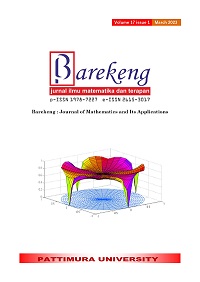IMPLEMENTATION OF THE STEP FUNCTION INTERVENTION AND EXTREME LEARNING MACHINE FOR FORECASTING THE PASSENGER’S AIRPORT IN SORONG
Abstract
This study aims to forecast the number of passengers departing at the domestic departure terminal at Domine Eduard Osok Sorong Airport in 2022 using the Autoregressive Integrated Moving Average (ARIMA) method, ARIMA with Step Function Intervention, and Extreme Learning Machine (ELM). The knowledge of the number of passengers can help the airport prepare facilities. The residual ARIMA model (0,1,0) has no serial correlation (random walk) based on the Ljung-Box test. The MAPE value of the ARIMA model (0,1,0) is 65.47% which means poorly fitted. Because of it, the researchers propose an intervention in the ARIMA model. The RMSE and MAPE ARIMA Intervention (1,0,0) (0,1,0) [12] were 9,027.671 and 35.86%, respectively. Besides, this study also employed the ELM method, which has a MAPE error measurement value of 30.64%. The ELM method has the lowest error measurement results among the three methods. Therefore, the ELM method is suitable for forecasting the number of passengers with predicted values from June to September 2022 as follows: 47985, 37821, 31247, and 33578. On the other hand, intervention in ARIMA can reduce MAPE by 45%.
Downloads
References
H. Bonakdari, J. P. Pelletier, and J. Martel-Pelletier, “A reliable time-series method for predicting arthritic disease outcomes: New step from regression toward a nonlinear artificial intelligence method,” Comput. Methods Programs Biomed., vol. 189, p. 105315, 2020.
H. Hartati, “Penggunaan metode ARIMA dalam meramal pergerakan Inflasi,” J. Mat. Sains dan Teknol., vol. 18, no. 1, pp. 1–10, 2017.
C. Sulistyowati, E. Farihah, and O. S. Hartadinata, Anggaran perusahaan: teori dan praktika. Scopindo Media Pustaka, 2020.
H. N. Tantika, N. Supriadi, and D. Anggraini, “Metode seasonal ARIMA untuk meramalkan produksi kopi dengan indikator curah hujan menggunakan aplikasi R di kabupaten Lampung Barat,” Matematika, vol. 17, no. 2, pp. 49–58, 2018.
A. N. Alfiyatin, W. F. Mahmudy, C. F. Ananda, and Y. P. Anggodo, “Penerapan Extreme Learning Machine (ELM) untuk peramalan laju inflasi di Indonesia,” J. Teknol. Inf. dan Ilmu Komput., vol. 6, no. 2, pp. 179–186, 2018.
H. Fransiska, P. Novianti, and D. Agustina, “Permodelan curah hujan bulanan di kota Bengkulu dengan Seasonal Autoregressive Integrated Moving Average (SARIMA),” Semin. Nas. Off. Stat., vol. 2019, no. 1, pp. 390–395, 2020.
B. G. Prianda and E. Widodo, “Perbandingan metode seasonal ARIMA dan Extreme Learning Machine pada peramalan jumlah wisatawan mancanegara ke Bali,” BAREKENG J. Ilmu Mat. dan Terap., vol. 15, no. 4, pp. 639–650, 2021.
S. Putri and A. Sofro, “Peramalan jumlah keberangkatan penumpang pelayaran dalam negeri di pelabuhan Tanjung Perak menggunakan metode ARIMA dan SARIMA,” Stabilitas Sist. Din. Pertumbuhan Sel Kanker Dengan Ter. Radiasi, vol. 10, no. 1, pp. 61–67, 2022.
A. H. Primandari and M. D. Kartikasari, Analisis Runtun Waktu dengan R, 1st ed. Yogyakarta: Universitas Islam Indonesia, 2020.
I. S. Nurjanah, D. Ruhiat, and D. Andiani, “Implementasi model Autoregressive Integrated Moving Average (ARIMA) untuk peramalan jumlah penumpang Kereta Api di pulau Sumatera,” TEOREMA Teor. dan Ris. Mat., vol. 3, no. 2, p. 145, 2018.
H. Panjaitan, A. Prahutama, and S. Sudarno, “Peramalan jumlah penumpang kereta api menggunakan metode ARIMA, intervensi dan ARFIMA (studi kasus : penumpang kereta api kelas lokal ekonomi DAOP IV Semarang),” J. Gaussian, vol. 7, no. 1, pp. 96–109, 2018.
G. E. . Box, G. M. Jenkins, G. C. Reinsel, and G. M. Ljung, Time series analysis: forecasting and control, 5th ed. New Jersey: Wiley Series in Probability and Statistics, 2015.
A. Crystine, A. Hoyyi, and D. Safitri, “Analisis intervensi fungsi step (studi kasus pada jumlah pengiriman benda pos ke Semarang pada tahun 2006-2011),” Concept Commun., vol. null, no. 23, pp. 301–316, 2019.
J. M. Park and J. H. Kim, “Online recurrent extreme learning machine and its application to time-series prediction,” Proc. Int. Jt. Conf. Neural Networks, vol. 2017-May, pp. 1983–1990, 2017.
Q. Humaini, “Jaringan syaraf tiruan Extreme Learning Machine (ELM) untuk memprediksi kondisi cuaca,” Skripsi, pp. 1–86, 2015.
G. Huang, G. Bin Huang, S. Song, and K. You, “Trends in extreme learning machines: A review,” Neural Networks, vol. 61, pp. 32–48, 2015.
Z. Kafara, F. Y. Rumlawang, and L. J. Sinay, “Peramalan curah hujan dengan pendekatan Seasonal Autoregressive Integrated Moving Average (SARIMA),” vol. 11, pp. 63–74, 2017.
Copyright (c) 2023 Nur Faizin, NF, Achmad Fauzan, AF, Arum Handini Primandari, AHP

This work is licensed under a Creative Commons Attribution-ShareAlike 4.0 International License.
Authors who publish with this Journal agree to the following terms:
- Author retain copyright and grant the journal right of first publication with the work simultaneously licensed under a creative commons attribution license that allow others to share the work within an acknowledgement of the work’s authorship and initial publication of this journal.
- Authors are able to enter into separate, additional contractual arrangement for the non-exclusive distribution of the journal’s published version of the work (e.g. acknowledgement of its initial publication in this journal).
- Authors are permitted and encouraged to post their work online (e.g. in institutional repositories or on their websites) prior to and during the submission process, as it can lead to productive exchanges, as well as earlier and greater citation of published works.






1.gif)



